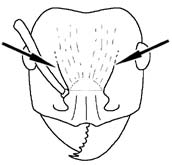Key to Tetramorium of the southwestern Australian Botanical Province
This worker key is based on: Heterick, B. E. 2009b. A guide to the ants of South-western Australia. Records of the Western Australian Museum, Supplement 76: 1-206. Part 2.
You may also be interested in
1
- Antenna 12-segmented (introduced spp.) . . . . . 2
- Antenna 11-segmented (native spp) . . . . . 3
2
return to couplet #1
- Anterior margin of clypeus entire (Figure 691); smaller species (TL ≈ 2 - 2.5 mm) . . . . . . Tetramorium simillimum
- Anterior margin of clypeus notched (Figure 692); larger species (TL ≈ 3.5 - 4.5 mm) . . . . . . Tetramorium bicarinatum
3
return to couplet #1
- Dorsum of petiole and postpetiole smooth and shining, almost devoid of sculpture (black species) . . . . . . Tetramorium sp. JDM 522
- At least one of the nodes with distinct sculpture (species with some colour) . . . . . 4
4
return to couplet #3
- Propodeum unarmed or with vestigial denticles at posterior angles . . . . . . Tetramorium sp. JDM 515
- Propodeum armed with moderately stout spines . . . . . 5
5
return to couplet #4
- In profile, mesosoma smoothly curved, without a hint of a metanotal groove (Figure 693a); dorsum of petiolar node large and triangular in cross section (Figure 693b) . . . . . Tetramorium sp. JDM 1007
- In profile, promesonotum gradually declining towards propodeum, not smoothly rounded (Figure 694); metanotal groove usually indicated by shallow depression or lateral indentations; dorsum of petiolar node smaller and rectangular in cross-section (e.g. Figure 695) . . . . . 6
6
return to couplet #5
- Antennal scrobes distinctly continuing to or close to vertex of head, sculpture within scrobes often reduced to fine punctuation with longitudinal rugulae absent or vestigial (Figure 696) . . . . . 7
- Antennal scrobes not continuing beyond eye, often indistinct; sculpture within scrobes mostly similar to rest of vertex with longitudinal rugulae distinct (Figure 697) . . . . . 10
7
return to couplet #6
- Eye very large (ocular diameter > 0.3 x HW); eye situated behind midpoint of head (Figure 698) . . . . . . Tetramorium megalops
- Eye smaller (ocular diameter < 0.3 x HW); eye situated at or close to midlength of head capsule (Figure 699) . . . . . 8
8
return to couplet #7
- Brown species . . . . . . Tetramorium sp. JDM 884
- Concolorous orange, or orange with darker head capsule . . . . . 9
9
return to couplet #8
- Clypeus not transversely concave or with median notch; viewed from above, dorsum of node trapezoid in shape (Figure 700), the anterior margin shorter than the posterior margin, and the dorsal surface distinctly longer than broad; base of gaster usually sculptured with fine, parallel, longitudinal striolae or finely microreticulate . . . . . . Tetramorium striolatum
- Clypeus transversely concave or with median notch; viewed from above, dorsum of node square, about as wide as long (Figure 701); base of gaster either smooth and shining or with faint, superficial microreticulation . . . . . . Tetramorium viehmeyeri
10
return to couplet #6
- Postpetiolar dorsum smooth and shining; head, mesosoma and nodes reddish-orange, gaster and appendages yellow . . . . . . Tetramorium sp. JDM 1072
- Postpetiolar dorsum sculptured; often bicoloured black- or brown-and-yellow, or reddishbrown-and-orange, in light coloured forms coxae nearly always darker than mesosoma (possibly two or more species involved here) . . . . . . Tetramorium impressum











